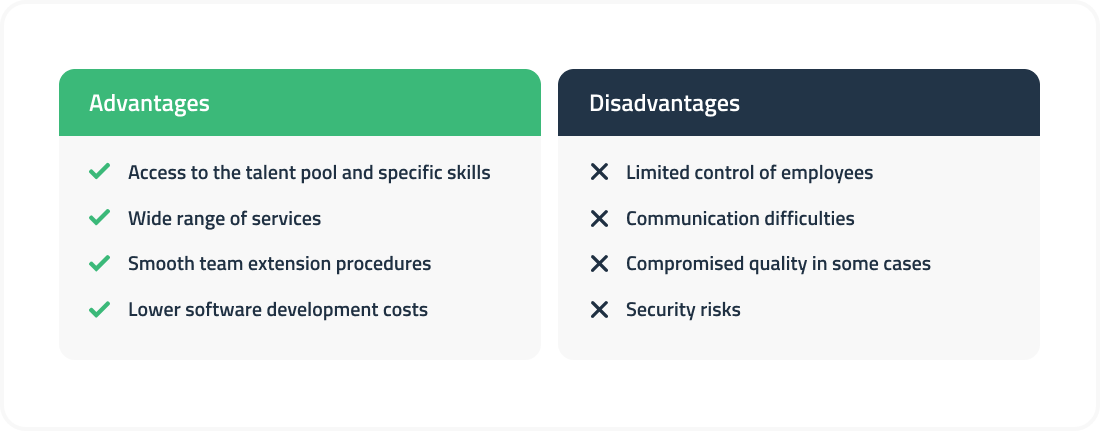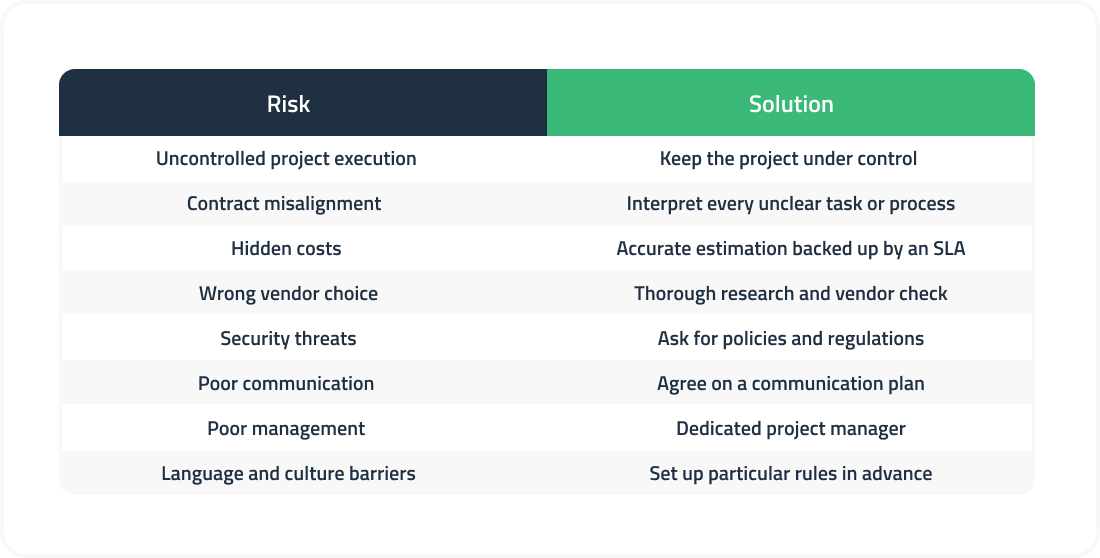

8 risks of IT outsourcing and ways to avoid those
Outsourcing has repeatedly proven that it’s an excellent way of developing quality projects without spending an unreasonable amount of money and other company resources such as human, physical, or intellectual. However, there are certain risks of IT outsourcing that come with the territory. So, let’s learn how to deal with threats to avoid distress, ruined projects, and damaged work relationships. But, before we proceed to risks, please read about the reasons for outsourcing.
Consider IT outsourcing? Explore DICEUS custom software development services.
Why do businesses and tech companies outsource software development?
IT outsourcing is a well-known and widespread practice of hiring a third-party vendor to handle a whole or a part of the development project otherwise managed by an in-house team.
The most common reasons for outsourcing are as follows:
- The lack of local and regular access to the needed talent and technological resources
- The development of multiple new products on a tight deadline
- Accelerated business processes
- Cost-cutting
Besides an obvious handful of risks of outsourcing IT that we’ll discuss next, there are a few advantages that come with it as well:
- The ability to shift the company’s focus to more pressing matters
- Access to a much wider variety of specialists
- Faster onboarding process
- No need to manage employee turnover on this particular project
- Scalability
Below are more details about the benefits and drawbacks of outsourcing IT jobs overseas.
Pros and cons of IT outsourcing
Technology is evolving at a breakneck pace, with IT infrastructure crucial in the modern business environment. Still, not every company may have adequate access to the required IT experts and resources. Therefore, IT outsourcing may become a feasible solution for many organizations to fill in-house talent or skill gaps. However, the management should carefully weigh all the pros and cons of this approach and decide whether or not a company should outsource its IT projects.

Advantages of IT outsourcing
- Access to a larger talent pool. When hiring employees, you are limited by your particular location. Otherwise, when outsourcing your project, you can involve talents from all over the world. Moreover, you can also reach experts with niche skills if required for your job.
- A wide range of services. Apart from freelancers, software vendors can offer many essential functions, including data storage or security monitoring. In addition, outsourcing will allow you to integrate advanced software services into your infrastructure.
- Flexible staffing options. Hiring IT staff can be challenging and costly. With outsourcing, you can skip the complex recruitment procedures and get as many employees as you need. Moreover, you can extend or reduce the team throughout the project according to your needs.
- Lower expenses. Outsourcing allows you to save both cost and time since you bear no expenses for recruitment and training procedures. Instead, you get the right specialists at an optimal price.
Disadvantages of IT outsourcing
- Limited control. Although you will provide all the necessary guidelines to your outsourced vendor, you are still going to entrust some aspects of control to a third party. You should admit that you won’t be able to control the outsourced experts the same way as your employees. That’s the reason to partner only with a trusted vendor.
- Communication issues. An outsourced vendor may not answer all your requests immediately. Depending on your inquiry, such communication lapses may cause troubles and ultimately reduce business efficiency. That’s why you need to establish procedures for efficient communication on urgent points.
- Compromised quality. Outsourcing will justify itself only if the project delivers the quality you expect. Unfortunately, this may not be the case with unreliable vendors. Therefore, make a wise choice of partner and adequately communicate the required quality standards.
- Security risks. In its essence, outsourcing implies relying on a third party to handle specific business data of your organization. This always bears security risks. Therefore, you should ensure that your vendor has the highest safety standards and will not expose your sensitive data.
What are the benefits of outsourcing IT services?
Let’s consider what practical value your organization will get when outsourcing IT services.
Improved focus. The need to outsource specific projects does not mean that an organization doesn’t have in-house IT staff. For example, some companies hire software developers overseas to compensate for the lack of particular skills or extend the team for a large-scale project. This allows managers to prioritize tasks and properly allocate the teams’ focus.
Higher competitiveness. IT vendors can do a lot to provide you with a competitive edge. Thus, they can add proactive IT leadership by making your business more efficient and agile, using the latest resources. In addition, IT outsourcing companies can help you implement innovative processes and a fresh business model that would ultimately reinforce your competitive position.
Enhanced labor efficiency. Third-party service providers manage human resources to maximize the use of the workforce for specific tasks. This allows them to achieve higher productivity. Furthermore, such an approach enables securing the jobs of regular employees and relieving them from switching between functions to address the rising demands.
Access to advanced technologies. Keeping up with evolving technologies is necessary for companies to stay afloat. However, not every business may have enough expertise and resources to implement cutting-edge solutions. In this regard, IT outsourcing can competently enable innovation for companies, as specialized vendors have knowledge and experience in breakthrough technologies.
What are the risks of outsourcing IT services?
When done correctly, outsourcing can be a relatively trouble-free process. However, a poor choice of a vendor, a lack of effective communication and experience, failure to see the bigger picture, unreasonable requirements from both sides, or security breaches can notably jeopardize the result.
Depending on vendors and their countries of origin, language and culture barriers can occur and set back the development process, disrupting the communication flow and causing problems with remote work management.
Nearly all of these potential risks and situations can be promptly dealt with — either with minimal damage or, in some cases, avoided altogether with careful planning. Below we’ll go through multiple accessible ways to manage them, with tips and explanations.
Top 8 risks of outsourcing IT services and how to manage them
Our team has managed to single out the eight most frequently occurring outsourcing risks and provide practical solutions to them.

Risk 1. Uncontrolled project execution
The first risk on our list is simultaneously the most frequently occurring one. No business owner likes to lose control, especially on their project. However, the very definition of outsourcing is to hand it over to the other company. Sometimes, the project gets accidentally let loose or excessively overmanaged, and it’s hard to find a balance.
Solution: Keeping the project under control
Before embarking on a journey to find the right service provider, take your time to plan out which responsibilities you’ll be handing over to them and how hands-on you will be during the project. Develop a roughed-out plan first, and be sure to point out which processes and results you expect.
Then, after choosing a vendor, it’s time to make that plan more detailed. Review and preferably put into writing the expected deadlines for each part of the project (a professional vendor will provide you with a Work Breakdown Structure, a document where the project is divided into smaller parts). Try to avoid having any turning points that were not previously discussed.
It’s also essential to agree on how the vendor will keep you in the loop — frequent meetings, complete reports, quick email updates, etc. Finally, keep track of the KPIs and relevant metrics to add a more grounded approach to your supervision style.
The best way to control the project is to hire a dedicated Project Manager. Learn more about this option.
Risk 2. Contract misalignment and disagreements
There can also be a possibility of exaggerated or unreasonable expectations if both teams fail to discuss every task beforehand. It may lead to overly critical feedback and ruin the relationship because the service provider should’ve cared about something not clearly specified in the contract.
Solution: Addressing every interpretation of tasks and processes
At times, disagreements over some contractual terms or features can happen because not all team members are brought up to speed on all the details, especially when many employees and variables are involved. Try to include both decision-makers and relevant staff in the negotiation process before the contract is signed.
The task interpretations can also vary — that’s why it’s better to encourage the team members to speak up on every matter that appears vague or overcomplicated. Still, there’s no 100% guarantee that problems won’t arise, so it’s better to have at least one representative from each team designated to deal with such issues.
Another suggestion is to manage your process or timeline expectations. In this way, you can stop potential conflicts and misunderstandings before they surface. For example, management can know how long a project may take to finish, which may not coincide with the developers’ estimated timeline.
Risk 3. Hidden costs
Among the dangers of outsourcing, this sneaky mood ruiner called hidden costs sometimes fails to be considered in the planning stage. Such unforeseen circumstances can come from unexpected troubleshooting, unplanned software or project upgrades, extra services, or some other expenses that weren’t previously mentioned.
Solution: Accurate service estimation, backed and followed by an SLA
Try to make the overall service estimation as all-in as possible. Perhaps consider turning to a professional analyst or a QA with relevant experience if you don’t have the amount of tech-savviness required for this specific project. The outside expert may better see the bigger picture and include some usual expenses that you missed.
Take a closer look at all the estimates your potential vendor provides and which type of contract they prefer. It can be a Fixed Price (per feature or iteration), Time and Materials contract, or a Flexible Scope framework. You can even check the amount of overtime the outsourcing team has clocked in by using a particular time tracking software.
Another helpful thing to consider is signing a Service Level Agreement and knowing beforehand about all the hosting costs, both scheduled and unscheduled team visits, acquiring extra pieces of essential equipment, fees, etc.
The best way to mitigate extra costs or understand when those may arise is through business analysis. Learn how a discovery phase may help you.
Risk 4. Wrong choice of vendor
By delegating your project to a third party, there’s always a risk of running into an unscrupulous vendor. As a result, you may end up with a subpar quality product, failed deadlines, lost customers or jobs, and even security violations. Whether it’s because a vendor did some extra embellishment with self-presentation or you under-vetted your candidates, here’s how to avoid it.
Solution: Background check and thorough research
It’s crucial to get a full scope of the outsourcing company’s background, expertise, and all selection of projects. First, go through their portfolio on their website. You may even contact some of the previous clients and ask for more detailed feedback beyond what you can read in a short review.
Except, don’t end just there. If you have some doubts left, ask around in the outsourcing community, review platforms for references, and always demand proof of how they communicate, treat less experienced clients, deal with competition, etc.
Aside from current and previous clients, check for partners as well. If they have any, make sure they are also experienced and have a decent reputation. But, of course, you don’t only judge someone by their name and reputation — their choice of friends and partners can also be quite telling.
Here’s a helpful guide on how to choose a reliable software vendor.
You can download it right now.
Risk 5. Security threats and legal issues
One of the most dangerous IT outsourcing risks is a significant security breach, leading to the loss of sensitive data and subsequent cyberattacks. Intellectual Property is considered one of the most prized possessions of almost every company. Among other crucial data is your employees’ and clients’ private and financial information.
Solution: Make sure they follow policies and regulations
Depending on the industry, multiple standards and regulations ensure data protection. For example, ISO/IEC 27001 provides valuable requirements on how companies should handle their information security. Other useful standards are NIST SP 800-53, HIPAA, GLBA, Sarbanes-Oxley, etc. Choose a vendor that is extra diligent about following the needed regulations and goes above and beyond to ensure their clients are protected.
However, policies and standards are not the only way to protect your data and assets. Non-disclosure agreements are also a great way to legally ensure you won’t end up with stolen information, data leaks, or other cybercrimes. Pay attention to how a potential vendor reacts to you offering them to sign an NDA — if they don’t have malevolent intentions or have nothing to hide, they won’t oppose that.
We ensure absolute data security while cooperating with our customers. Learn more about us.
Risk 6. Poor communication
Not enough time and effort to establish and adopt effective communication and knowledge transfer can significantly undermine the project’s success. In addition, the lack of structure, not sharing essential information, and gaps between critical parts in the process lead to both sides’ team members pulling the project in opposite directions.
Solution: Make your approach more structured
Adding structure to your communication process helps you see the entire process and everyone’s part in it more clearly. Start by incorporating a particular hierarchy, even if your company is not used to it. Then, add various levels of communication that involve specific groups of people working on the same issues.
Make sure that every detail is discussed throughout the entire development process. Have scheduled progress reviews, frequent sessions, and multi-formatted meetings to determine the problems as soon as they appear to avoid dragging them on.
Another way of preventing miscommunication problems in the future is to ensure your outsourcing vendor has all the information from the start. They have to have a full picture of your needs and demands to work with them properly. So, provide complete documentation, including internal guides, strategies, and databases, show around your work process, and have comprehensive discussions with all team members.
Risk 7. Mismanaging remote teams
Another management and communication issue among the ordinary risks of outsourcing, especially today, is mishandling remote teams. The location has never been such a non-issue regarding reaching out and working, although it brings other problems — how to effectively control and steer remote workers.
Solution: Constant check-ins and feedback
First, be aware of the time zones. It may not be very relevant if you have a couple of countries between you on a map. Still, the difference is much more significant if you’re, for example, from a European country and your vendor is located in the USA or Asia.
To remedy that, plan the overlapping hours during which all team members will be easily reachable via email, call, or video chat, and plan your next online gathering. Then, use that time to deal with as many pressing issues as possible.
Another problem with remote teams is the lack of timely feedback. Frequent check-ins and regular praise, if everything is going right, can distinctly boost the team’s morale and help you feel abreast with every decision and change.
Make sure you choose a vendor with significant remote work experience. That way, they may already know the common pitfalls and how to avoid them.
Need seasoned software developers? We offer IT staff augmentation services.
Risk 8. Language and culture barriers
Outsourcing opened a whole new market of specialists. There’s no problem now to search internationally and have a quality service provider from the opposite part of the globe. But with this unavoidably come cultural and language-related difficulties that disrupt the most important thing in partnership — communication.
Solution: Study the differences and set your standards
First, you need to become well acquainted with local laws and regulations that can influence contracts and foreign relations. Cultural differences are not an issue to be dreaded either. Of course, different countries have different work styles, and their boundaries may vary from yours. However, there’s nothing thorough research and mutual agreements can’t be fixed.
And set your standards for English language proficiency, especially if it’s a second or a third language for you both. It can affect how well they understand your requirements and assure them they won’t go off track due to a simple misunderstanding.
To find out the team’s language proficiency, don’t rely too much on their descriptions of themselves – insist on audio or video calls to see for yourself. If they refuse and are pretty adamant about written communication, it may indicate many issues.
Bottom line
With careful planning and thought-out management, it’s possible to mitigate the risks of outsourcing the IT services we’ve mentioned above. First, make sure you invest your time into proper research – this way, you can avoid half of the issues that stem from a lack of knowledge. And last but not least — be transparent and demand the same from your vendor.





